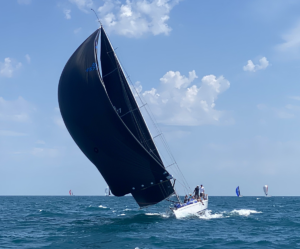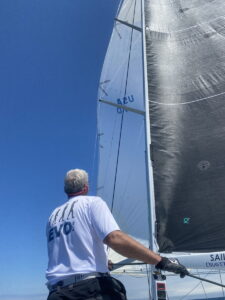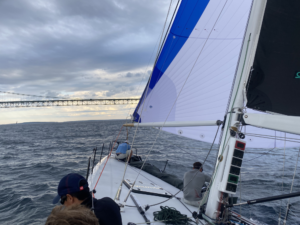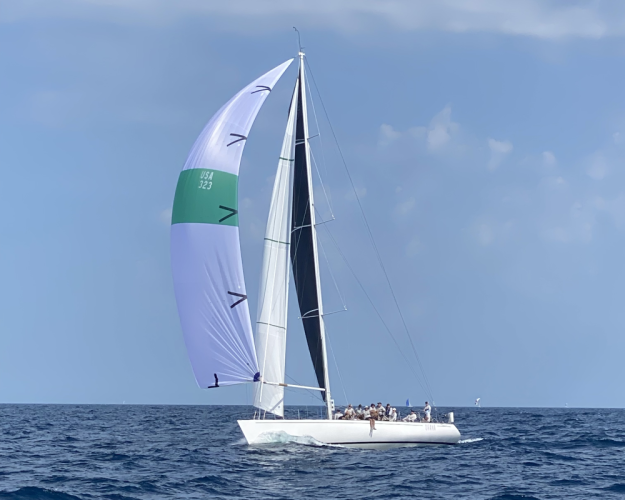Most sailors are familiar with the daunting feeling of hoisting the Spinnaker for the first time and in the case of many sailors, that apprehension can be the reason why the Spinnaker stays in the locker forever. But once you have seen the spinnaker flying in all its colorful splendor, pulling your boat along in a breeze that would otherwise be unsailable, there really is no turning back.
On my own boat, I have always been happy inheriting used sails and was once lucky enough to be given TWO second-hand spinnakers. But unfortunately, it was a kind of Goldilocks story where nothing really fit. I hoisted the first one, but it being the size of a handkerchief compared to my boat, it was like trying to pull a horse-cart with a squirrel. That spinnaker went straight back into the bag.
Then, I hoisted the second one, but when the head of the sail reached the top of the mast, there was still half a spinnaker in the bag. So, that spinnaker too went back into its bag, and I was left still needing a spinnaker for my boat.
The moral of this story is obvious: Every boat is different, and if you want to dress it properly and avoid ending up with a sail-locker full of waisted cloth, you need to know the exact dimensions before you go and buy yourself a new sail. Luckily for you, these measurements are very simple to take.
In this article, I will share with you how to measure your boat for your new symmetrical or asymmetrical spinnaker with only 2 measurements: The max hoist and the tack attachment to sheeting block. These simple measurements can be given to the sailmaker and from that, he will be able to make a sail that fits your boat perfectly, ensuring your ultimate sailing performance and happy days on the water.
 Alternatives to Measuring Onboard
Alternatives to Measuring Onboard
If you have a production boat with its original rig, you can save yourself a lot of time by looking up the specs of your boat model. However, if your rig has been modified you will need to take the measurements onboard the boat, to ensure that you do not end up with a misfit and wasted money.
If you are replacing an old spinnaker and were happy with its dimensions, you can also pull the measurements off that or simply give the old sail to your sailmaker and ask him to copy it. Then again, this is not an option if the old sail has been ripped to shreds which is a common fate among spinnakers.
STEP 1) MEASURE THE MAX HOIST
The max hoist is the distance measured between the halyard block at the top of the mast and the tack attachment point on your bow, often located where the forestay attaches to the deck. (Even though the Spinnaker has no tack attached to the bow, the distance between these two points determines the height of your sail)
But before taking this measurement there are two things that you need to consider:
Does your Boat have a Masthead or Fractional Rig?
The position of the halyard block will depend on what kind of rig your boat has. On a masthead rig, the spinnaker head will attach to the very top of the mast, whereas on a fractional rig, it will be positioned further down, somewhere slightly above the forestay.
Does your Boat have a Bowsprit?
With a bowsprit, you have the option of setting your tack attachment point for your asymmetrical spinnaker at the end of it, increasing the length of the max hoist. With the tack attachment point set at the bow, the bottom usually must be raised as it would otherwise be rubbing against the pulpit. This is not an issue with a tack attachment point set at the bow.
The easiest way to take this measurement is by hoisting a surveyor’s tape measure up the mast using the spinnaker halyard. Hoist it all the way to the halyard block, making sure you keep it taught as you take the measurements at the tack attachment point on the bow.
You now have your first measurement for your new Spinnaker.
 STEP 2) MEASURE TACK TO SHEETING BLOCK
STEP 2) MEASURE TACK TO SHEETING BLOCK
The second measurement will be taken between the tack attachment point for asymmetrical or the bow for symmetrical, and the sheeting block, following the curvature of the toe rail. Here one thing should be taken into consideration: Do you have an adjustable toe rail or will the spinnaker be sheeted to a fixed position?
Fixed Sheeting Block Position
If your sheeting block is in a fixed position, it is simple; the measurement will be taken to that.
Adjustable Toe Rail
If you have an adjustable toe rail, you need to first determine where you are going to fix the sheeting block. The position of the block should be set considering both a maximum sheeting length and a good angle to the sheet winch.
Once your sheeting block position has been determined, the measurement can be taken. Again, use the surveyor’s tape measure, and measure between the block and the tack attachment point at the bow or bowsprit, making sure to keep the tape measure taught.
You now have your second and final measurement for your new Spinnaker.
Other Things your Sailmaker Wants to Know
Spinnaker Sock
Using a spinnaker sock is a great way to ease sail handling and minimize the chance of a sail shredding disaster. The use of a spinnaker sock will influence the calculations of your spinnaker max hoist length, as the sail’s head will be attached to the bottom of the sock, slightly reducing the length of the spinnaker. It is therefore important to let your sailmaker know if you do intend to use a spinnaker sock.
Spinnaker Furler
For those who do not want to take any chances and risk ending up in a YouTube spinnaker fail compilation, the ultimate tool for easing sail handling is the spinnaker furler.
If you intend to use one, it is important to inform your sailmaker of what model you have, so he can make your spinnaker to meet its specifications.
Spinnaker Pole
A spinnaker pole can be used with both a symmetrical and asymmetrical spinnaker and is a great tool for supporting your sail shape when unsteady wind or swell cause it to flap around.
Inform your sailmaker if you intend to use a pole on your spinnaker.
 Spinnaker Colors
Spinnaker Colors
One of the great joys of purchasing a new spinnaker is the creative freedom to choose your unique design and color scheme, and you will usually find a wide selection of colors available in your sailmaker’s catalogue.
But, although vividly colored Spinnakers are great, fluorescent colors are not recommended for offshore or trans-ocean sailing as they are less resistant to UV and will have a shorter lifespan when left in the sun for days at an end.
Club Racing Rules
If you are buying a new spinnaker for racing, remember to check your club’s class rules. The rules can sometimes be very strict and dictate the size of your spinnaker.
The Measurements have been Taken, What’s Next?
Once you have provided the measurements mentioned above, your sailmaker is ready to start on your sail. But there is one more thing that is worth considering before you give him the green light. What about sailcloth material?
Woven nylon sailcloth is no doubt the most common sailcloth used for making spinnakers, but why is it so good, what are the alternatives, and who produces the best sailcloth on the market?
To get a better understanding of the different spinnaker sailcloth materials and which will suit your specific boat and sailing application best, check out ‘A Guide to Sailcloth for Spinnakers and Code Sails’.

